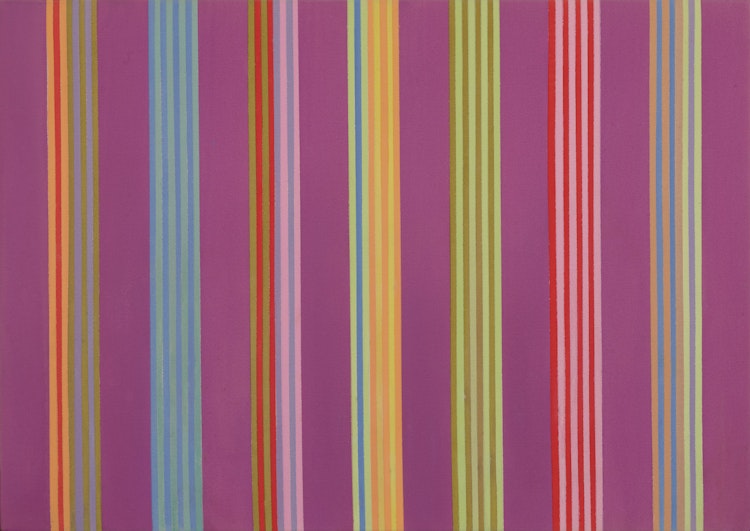Hell's Calendar #3 by Gene Davis

Gene Davis
Hell's Calendar #3
acrylic on canvas
21.25 x 30 in ( 54 x 76.2 cm )
Auction Estimate: $15,000.00 - $20,000.00
Price Realized $18,000.00
Sale date: May 28th 2025
Purchased from Dunkelman Gallery, Toronto, early 1970s
Private Collection, Toronto
Donald Wall, ed., "Gene Davis", New York, 1975, page 27
Jacquelyn Days Serwer with essays by Douglas Davis and Donald Kuspit, "Gene Davis: A Memorial Exhibition", Washington, 1987, page 43
In an interview with Donald Wall, Davis addresses the essential question of why he chose stripes. He admits: “That’s not easy to answer. At the very beginning, I saw the equal-width stripe format as a kind of response to the painterliness that was in the air in the late Fifties. Stripes, when evenly deployed, have a quality of clarity that seemed absent in abstract expressionism.”
The richness of the coloured stripes in Davis’s work "Hell’s Calendar #3", which features seven larger stripes enclosing eight smaller stripes of various shades of green, blue, red, pink and orange, creates a push-and-pull effect against the deep violet background. Donald Kuspit describes the effect of the stripes: “Davis’s color-stripes serve a double function. They can be read as metaphors for the states of consciousness that interpenetrate in ‘perception’, or introspective awareness, of duration, and they can be read as literal units in a spatial succession that is abstractly emblematic of temporal flow.”
Share this item with your friends
Gene Davis
(1920 - 1985)
Born in Washington, D.C., in 1920, Gene Davis worked as a sportswriter before his career as an artist began in 1949. Davis, a leading American artist of the twentieth century, contributed significantly to the Color Field and Post-Painterly Abstraction movements that reached prominence in the 1960s and the Washington Color School. Davis was never formally trained, which he viewed as a positive aspect that freed him from the traditional and limiting aspects of art schooling. Instead, Davis developed his artistic skills through the art institutions in Washington and regular visits to museums and galleries in New York. He also received guidance from friend, artist and curator Jacob Kainen.
His first exhibition of drawings took place at Washington’s Dupont Theatre Gallery in 1952, and the following year, he showed paintings at Catholic University. While gaining popularity in the 1960s, Davis’ art practice focused on spontaneity. In his early work, he explored the concept of musical abstraction, inspired by Paul Klee, which created a sense of rhythm through visual alliteration. His highly successful colour stripe works use this, and Davis has explained that he encourages each colour to be observed in how it operates across the painting to understand what his paintings mean fully. He exhibited his colour stripe paintings at the “Washington Color Painters", a travelling exhibition organized by Gerald Nordland, which premiered at the Washington Gallery of Modern Art in 1965. Throughout the rest of his career, Davis used a variety of methods, media, and sizes, from minuscule "micro-paintings," often no larger than half an inch in either direction, to large public installations as seen in his 1972 artwork “Franklin's Footpath,” made up of monumental stripes painted on the street in front of the Philadelphia Museum of Art.
The artwork of Gene Davis is held in various prominent collections, including the Museum of Modern Art, New York; the Smithsonian American Art Museum, Washington; the Walker Art Center, Minneapolis; and the San Francisco Museum of Modern Art.

